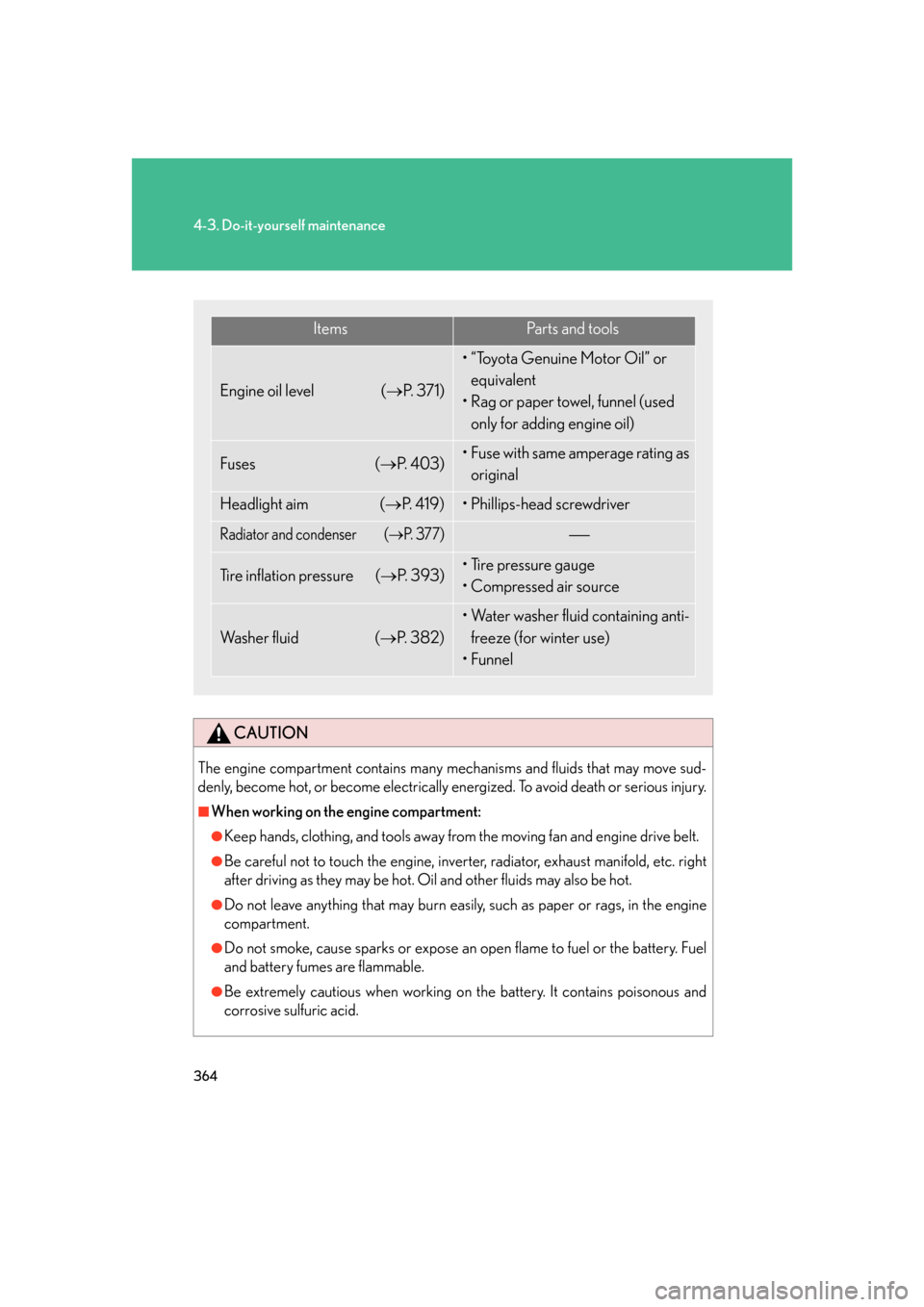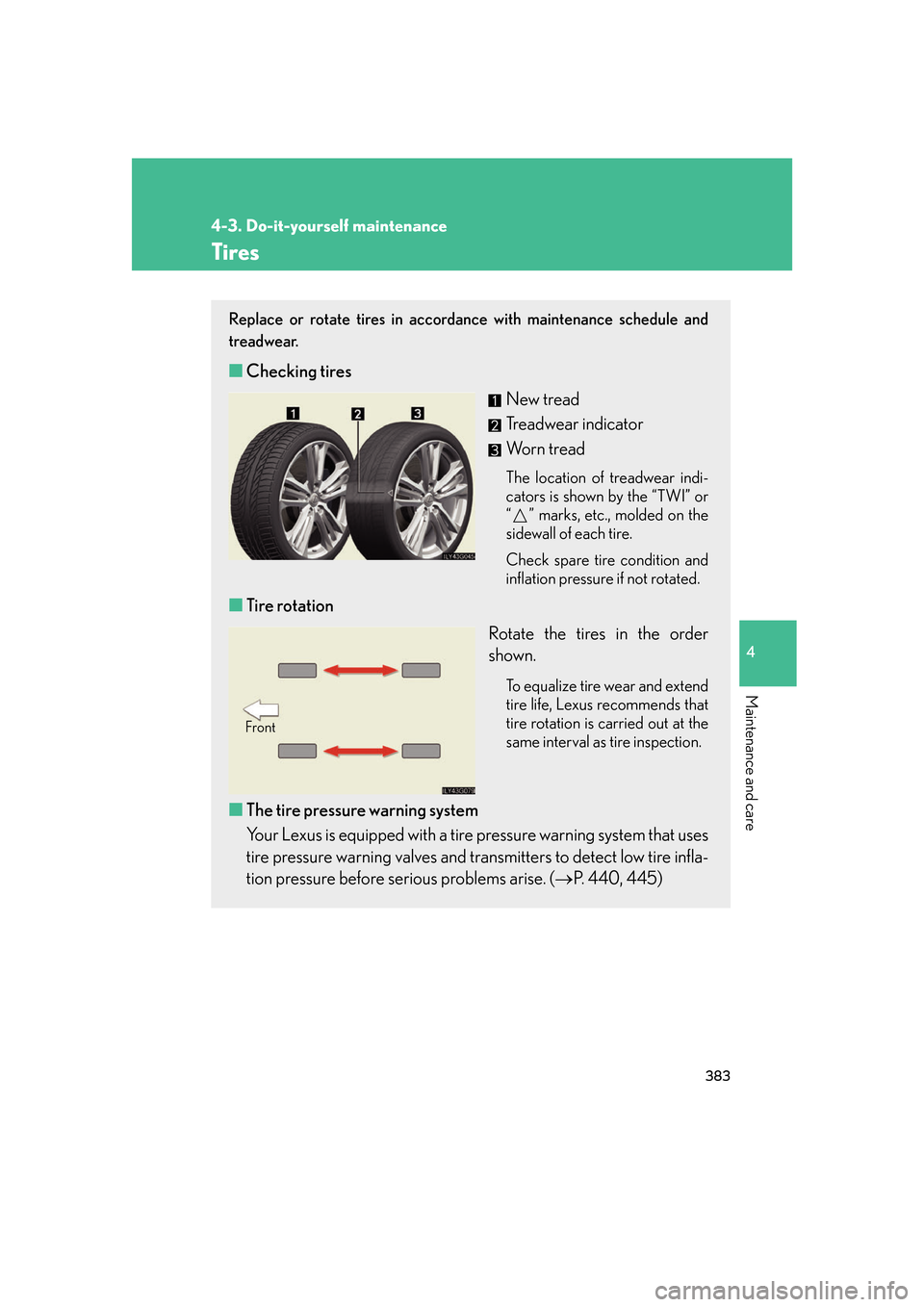inflation pressure Lexus GS450h 2007 Using the audio system / LEXUS 2007 GS450H FROM JULY 2006 PROD. OWNER'S MANUAL (OM30A05U)
[x] Cancel search | Manufacturer: LEXUS, Model Year: 2007, Model line: GS450h, Model: Lexus GS450h 2007Pages: 548, PDF Size: 16.31 MB
Page 4 of 548

TABLE OF CONTENTSIndex
iv
3-4. Using the hands-free
system......................................... 261
Hands-free system ....................... 261
Using the Bluetooth
®
phone ............................................. 265
Setting the hands-free
system ............................................ 278
3-5. Using the interior lights ......... 303 Interior lights list........................... 303
3-6. Using the storage
features ..................................... 306
List of storage fe atures.............. 306
3-7. Other interior features............ 312 Sun visors.......................................... 312
Vanity mirror ................................... 313
Clock .................................................. 314
Outside temperature
display ............................................. 315
Ashtrays ............................................ 316
Cigarette lighter ............................ 317
Power outlet .................................... 318
Seat heaters ..................................... 319
Seat heaters and
ventilators ...................................... 321
Armrest ............................................ 323
Rear sunshade ............................... 324
Floor mats........................................ 326
Trunk features................................ 327
Garage door opener .................. 329
Compass........................................... 334
Lexus Link System ...................... 338 4-1. Maintenance and care............ 352
Cleaning and protecting the
vehicle exterior .......................... 352
Cleaning and protecting the
vehicle interior............................ 354
4-2. Maintenance.............................. 357 Maintenance requirements ..... 357
General maintena nce ............... 359
Emission inspection and
maintenance (I/M)
programs ...................................... 362
4-3. Do-it-yourself
maintenance............................ 363
Do-it-yourself service
precautions .................................. 363
Hood.................................................. 366
Positioning the jack ..................... 367
Engine compartm ent.................. 369
Tires .................................................. 383
Tire inflation pressure................. 393
Wheels.............................................. 397
Air conditioning filter.................. 399
Electronic key battery ................. 401
Checking and replacing
fuses ............................................... 403
Headlight aim.................................. 419
Light bulbs ........................................ 421
4Maintenance and care
Page 7 of 548

vii
Tire
●Rotation
● Replacement
● Inflation pressure
● Information
P. 383
P. 461
P. 493
P. 498
Tail lights P. 122
Side marker light P. 122
Trunk P. 29
Rear window defogger P. 199
Door P. 25
Fuel filler door P. 55
Turn signal light P. 110
: If equipped
Page 199 of 548

179
2-5. Driving information
2
When driving
■Snow chain installation
Observe the following precautions when installing and removing chains.
●Install and remove tire chains in a safe location.
●Install tire chains on the rear tires.
●Install tire chains following the instructions provided in the accompanying
instructions.
CAUTION
■Driving with snow tires
Observe the following precautions to reduce the risk of accidents.
Failing to do so may result in a loss of vehicle control and cause death or serious
injury.
●Use tires of the size specified for your vehicle.
●Maintain the specified level of tire inflation pressure.
●Do not drive in excess of 75 mph (120 km/h), regardless of the type of snow tires
being used.
●Snow tires should be installed on all wheels.
■Driving with snow chains
Observe the following precautions to reduce the risk of accidents.
Failing to do so may result in the vehicle being unable to be driven safely, and may
cause death or serious injury.
●Do not drive in excess of the speed limit specified for the tire chains being used,
or 30 mph (50 km/h), whichever is lower.
●Avoid driving on bumpy road surfaces or over potholes.
●Avoid sudden turns and braking, as use of chains may adversely affect vehicle
handling.
●Slow down sufficiently before entering a curve to ensure that vehicle control is
maintained.
Page 371 of 548

Maintenance and care4
351
4-1. Maintenance and care ........ 352Cleaning and protecting the
vehicle exterior........................ 352
Cleaning and protecting the
vehicle interior......................... 354 4-2. Maintenance........................... 357
Maintenance requirements............................ 357
General maintena nce ............. 359
Emission inspection and
maintenance (I/M)
programs ................................... 362
4-3. Do-it-yourself
maintenance......................... 363
Do-it-yourself service
precautions ............................... 363
Hood .............................................. 366
Positioning the jack .................. 367
Engine compartment .............. 369
Tires ................................................. 383
Tire inflation pressure .............. 393
Wheels .......................................... 397
Air conditioning filter .............. 399
Electronic key battery .............. 401
Checking and replacing
fuses ............................................. 403
Headlight aim .............................. 419
Light bulbs...................................... 421
Page 381 of 548

361
4-2. Maintenance
4
Maintenance and care
Vehicle exterior
ItemsCheck points
Doors/trunk• Operate smoothly?
Engine hood• The lock system works properly?
Fluid leaks• Is there any leakage after parking?
Ti r e
• Inflation pressure is correct?
• Tire surfaces not worn or dam-aged?
• Tires rotated according to the
maintenance schedule?
• Wheel nuts are not loose?
CAUTION
■If the hybrid system is running
Turn off the hybrid system and ensure that there is adequate ventilation before per-
forming maintenance checks.
Page 384 of 548

364
4-3. Do-it-yourself maintenance
CAUTION
The engine compartment contains many mechanisms and fluids that may move sud-
denly, become hot, or become electrically energized. To avoid death or serious injury.
■When working on the engine compartment:
●Keep hands, clothing, and tools away from the moving fan and engine drive belt.
●Be careful not to touch the engine, inverter, radiator, exhaust manifold, etc. right
after driving as they may be hot. Oil and other fluids may also be hot.
●Do not leave anything that may burn easily , such as paper or rags, in the engine
compartment.
●Do not smoke, cause sparks or expose an open flame to fuel or the battery. Fuel
and battery fumes are flammable.
●Be extremely cautious when working on the battery. It contains poisonous and
corrosive sulfuric acid.
ItemsPa r t s a n d t o o l s
Engine oil level ( P. 3 7 1 )
• “Toyota Genuine Motor Oil” or
equivalent
• Rag or paper towel, funnel (used
only for adding engine oil)
Fuses ( P. 4 0 3 )• Fuse with same amperage rating as
original
Headlight aim ( P. 4 1 9 )• Phillips-head screwdriver
Radiator and condenser (P. 377)
Tire inflation pressure ( P. 393)• Tire pressure gauge
• Compressed air source
Wa s h e r f l u i d ( P. 3 8 2 )
• Water washer fluid containing anti-
freeze (for winter use)
•Funnel
Page 403 of 548

383
4-3. Do-it-yourself maintenance
4
Maintenance and care
Tires
Replace or rotate tires in accordance with maintenance schedule and
treadwear.
■Checking tires
New tread
Treadwear indicator
Worn tread
The location of treadwear indi-
cators is shown by the “TWI” or
“ ” marks, etc., molded on the
sidewall of each tire.
Check spare tire condition and
inflation pressure if not rotated.
■Tire rotation
Rotate the tires in the order
shown.
To equalize tire wear and extend
tire life, Lexus recommends that
tire rotation is carried out at the
same interval as tire inspection.
■The tire pressure warning system
Your Lexus is equipped with a tire pressure warning system that uses
tire pressure warning valves and tr ansmitters to detect low tire infla-
tion pressure before serious problems arise. ( P. 440, 445)
Front
Page 404 of 548

384
4-3. Do-it-yourself maintenance
Installing tire pressure warning valves and transmittersWhen replacing tires or wheels, tire pressure warning valves and trans-
mitters must also be installed.
When new tire pressure warning va lves and transmitters are installed,
new tire pressure warning valve and transmitter ID codes must be regis-
tered in the tire pressure warning computer and tire pressure warning
system must be initialized. Have tire pressure warning valve and transmit-
ter ID code registered by your Lexus dealer. ( P. 386)
Initializing the tire pressure warning system
■ The tire pressure warning system must be initialized in the following
circumstances:
● When changing the tire inflation pressure by changing traveling
speed or load weight, etc.
● When changing the tire size.
When the tire pressure warning sys tem is initialized, the current tire
inflation pressure is set as the pressure benchmark.
Page 405 of 548

385
4-3. Do-it-yourself maintenance
4
Maintenance and care
■How to initialize the tire pressure warning system
Park the vehicle in safe place and turn the power switch to “OFF”
mode.
While the vehicle is moving, initialization is not performed.
Adjust the tire inflation pressure to the specified cold tire inflation
pressure level. ( P. 493)
Make sure to adjust the tire pressure to the specified cold tire inflation
pressure level. The tire pressure warning system will operate based on
this pressure level.
Turn the power switch to “IG-ON” mode.
Push and hold the tire pressure
warning reset switch until the tire
pressure warning light blinks
slowly three times and the mes-
sage “PRESSURE INITIAL”
appears on the multi-information
display.
Wait for a few minutes with the “IG-ON” mode, and then turn
power switch to the “OFF” mode.
STEP1
STEP2
STEP3
STEP4
STEP5
Page 408 of 548

388
4-3. Do-it-yourself maintenance
■Maximum load of tire
Check that the maximum load of the replaced tire is greater than 1 /2 of the Gross
Axle Weight Ratings (GAWR) of either the front axle or the rear axle, whichever is
greater.
As for the maximum load of the tire, see the load limit at maximum cold tire inflation
pressure mentioned on the sidewall of the tire, and as for the Gross Axle Weight
Ratings (GAWR), see the Certification Label. (
P. 393, 498).
■Tire types
1 Summer tires
Summer tires are high-speed performance tires best suited to highway driving
under dry conditions. Since summer tires do not have the same traction perfor-
mance as snow tires, summer tires are in adequate for driving on snow-covered
or icy roads. For driving on snow-covered roads or icy roads, the use of snow tires
is recommended. When installing snow tires, be sure to replace all four tires.
2 All season tires All season tires are designed to provide better traction in snow and to be ade-
quate for driving in most winter conditions , as well as for use year round. All sea-
son tires, however, do not have adequa te traction performance compared with
snow tires in heavy or loos e snow. Also, all season tires fall short in acceleration
and handling performance compared with summer tires in highway driving.
3Snow tires
For driving on snow-covered roads or icy roads, we recommend using snow tires.
If you need snow tires, select tires of the same size, construction and load capac-
ity as the originally installed tires. Since your vehicle has radial tires as original
equipment, make sure your snow tires also have radial construction. Do not install
studded tires without first checking loca l regulations for possible restriction.
Snow tires should be installed on all wheels. ( P. 1 76 )
■Initializing the tire pressure warning system
Initialize the tires with the tire inflatio n pressure adjusted to the specified level.